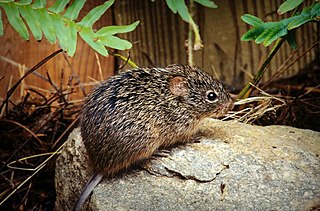
The rodent subfamily Sigmodontinae includes New World rats and mice, with at least 376 species. Many authorities include the Neotominae and Tylomyinae as part of a larger definition of Sigmodontinae. When those genera are included, the species count numbers at least 508. Their distribution includes much of the New World, but the genera are predominantly South American, such as brucies. They invaded South America from Central America as part of the Great American Interchange near the end of the Miocene, about 5 million years ago. Sigmodontines proceeded to diversify explosively in the formerly isolated continent. They inhabit many of the same ecological niches that the Murinae occupy in the Old World.
The golden Oldfield mouse or golden thomasomys is a species of rodent in the family Cricetidae. It is found in Colombia, Ecuador, Peru, and Venezuela. Both the common and genus name commemorate the British zoologist Oldfield Thomas who worked at the Natural History Museum, London and studied South American rodents.

Thomasomys is a genus of rodent in the family Cricetidae, named after British zoologist Oldfield Thomas. Nuclear DNA sequence analysis has indicated that it is a sister taxon to Rhagomys. It contains the following species:
Daphne's Oldfield mouse is a species of rodent in the family Cricetidae. It is found in Bolivia and Peru.
The Peruvian Oldfield mouse is a species of rodent in the family Cricetidae. It is found only in Peru.
The slender Oldfield mouse is a species of rodent in the family Cricetidae. It is found in Ecuador and Peru.
The Inca Oldfield mouse is a species of rodent in the family Cricetidae. It is found only in Peru.
The strong-tailed Oldfield mouse is a species of rodent in the family Cricetidae. It is found only in Peru.
Kalinowski's Oldfield mouse is a species of rodent in the family Cricetidae. It is found only in Peru.
The distinguished Oldfield mouse is a species of rodent in the family Cricetidae. It is found only in Peru.
Thomas's Oldfield mouse is a species of rodent in the family Cricetidae.
Rosalinda's Oldfield mouse is a species of rodent in the family Cricetidae. It is found only in Peru.
Taczanowski's Oldfield mouse is a species of rodent in the family Cricetidae. It is found only in Peru.

Antonio José Brack Egg was an agronomist engineer, an ecologist, and researcher. He was the first Peruvian Minister of the Environment. He is a national and international authority on issues pertaining to biological diversity and biocommercial development. He died after a brief hospitalization in 2014.
The Apeco Oldfield mouse is a species of rodent in the family Cricetidae. It is known only from a single locality in north central Peru, which includes Rio Abiseo National Park, where it was found in cloud forest at an elevation of 3300 m. The species name comes from the acronym for the Asociacion Peruana para la Conservacion de la Naturaleza. It is among the largest members of the genus.
The white-tipped Oldfield mouse is a species of rodent in the family Cricetidae. It is found in the Andes from central Ecuador to northern Peru, at elevations from 2500 to 3350 m, where it lives in montane forest.
The large-eared Oldfield mouse is a species of rodent in the family Cricetidae. It is known only from a single locality in the Andes in north central Peru, in montane forest at an elevation of 3300 m. It has terrestrial habits and is sympatric with T. apeco.
The Ashaninka Oldfield mouse is a species of rodent in the family Cricetidae. It is known only from a single locality in the Cordillera Oriental of the southern Peruvian Andes, in montane forest at an elevation of 3350 m. It has terrestrial habits. The common name refers to the Asháninka, the largest indigenous group of the Peruvian Amazon.
The Cajamarca Oldfield mouse is a species of rodent in the family Cricetidae. It is present in the Andes of northwestern Peru, where its habitats include shrubby páramo, montane forest, and secondary forest. The rodent is nocturnal and may be partly arboreal. It was formerly considered a subspecies of T. aureus. The common name comes from the Peruvian city and region of Cajamarca.

Thomasomys ucucha, also known as the ucucha thomasomys, is a rodent in the genus Thomasomys of the family Cricetidae. It is known only from high altitude forest and grassland habitats in the Cordillera Oriental of Ecuador. Seven other species of Thomasomys live in the same areas. First collected in 1903, T. ucucha was formally described as a new species in 2003 and most closely resembles T. hylophilus, which occurs further to the north. The species is listed as "vulnerable" in the IUCN Red List as a result of habitat destruction.



